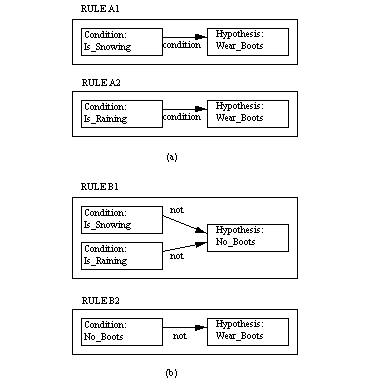6.5.1 OPERATIONAL CONSTRUCTS
6.5.1.3 The OR Construct
Each condition model of the previous sections can be regarded as a proposition. Models can be evaluated to a value. That is, each condition model, when evaluated, stands as either a true or false proposition.
DeMorgan's Theorem in propositional logic shows that two ORed propositions can be negated and ANDed together for a negated inference. Equation (EQ 10) below illustrates the statement "proposition P1 OR proposition P2 infer R1". This equation leads to equation (EQ 11), in which formalizes the statement "the negation of P1 AND the negation of P2 imply the negation of R1".
An example is illustrated in Figure 79 below. Here, if either boolean-based property model "Is_Snowing" or "Is_Raining" evaluate to true, the Hypothesis Wear_Boots would be set to true. However, in a production system, only ANDs are permitted. There are two possible configurations, as exemplified by (a) and (b) to duplicate the ORing behavior. Configuration (a) takes advantage of the ability of two different rules to confirm the same hypothesis. If either model is true, then the hypothesis is confirmed. However, there must be adequate conflict resolution built into the evaluation system so that if one model is false and the other is true, the hypothesis is true.
Configuration (b) introduces the negation and ANDing of the models, which requires the introduction of a negated hypothesis variable. An additional production relates the negated hypothesis to the original hypothesis.
Figure 79 Two Production Implementations of the OR Construct


